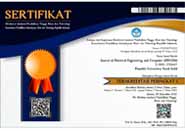Alat Pengukur Umur Lampu Dengan Teknologi Switch Cycles (KLIK)
Authors (s)
(1) Maria Beatrix (Universitas Tarumanagara, Jakarta)
Indonesia
(2) * Endah Setyaningsih
 (Universitas Tarumanagara, Jakarta)
(Universitas Tarumanagara, Jakarta) Indonesia
(3) Hadian Satria Utama (Universitas Tarumanagara, Jakarta)
Indonesia
(4) Yohanes Calvinus (Universitas Tarumanagara, Jakarta)
Indonesia
(5) Putra Lukita (Universitas Tarumanagara, Jakarta)
Indonesia
(*) Corresponding Author
AbstractPencahayaan adalah penggunaan cahaya untuk menerangi suatu objek. Salah satu sumber dari pencahayaan buatan adalah lampu. Masyarakat sangat membutuhkan lampu yang berkualitas dan tahan lama untuk kebutuhan sehari-hari. Salah satu faktor terpenting dari pemilihan lampu adalah umur lampu. Selama ini, umur lampu diukur dengan satuan jam. Standar nasional Indonesia (SNI) menguji umur lampu selama 6000 jam. Saat ini terdapat suatu teknologi baru yang berkembang terkait switch cycles (klik) untuk mengukur umur lampu. Sebuah alat ukur umur lampu perlu dibuat untuk mengetahui umur lampu dengan switch cycles (klik). Metode yang digunakan adalah perancangan alat. Tujuan dari perancangan alat ini adalah membuat alat yang bisa mengukur umur lampu dengan switch cycles (klik). Alat ukur umur lampu dengan teknologi switch cycles (klik) memiliki empat modul yaitu modul counter, modul internet, modul pemproses, modul penampil informasi. Modul counter melakukan switch cycles (klik) pada lampu. Modul internet menghubungkan alat ke internet. Modul pemproses melakukan pengolahan data. Modul penampil informasi menunjukkan informasi di LCD. Berdasarkan pengujian rancangan, semua modul pada alat berhasil bekerja sesuai dengan tujuannya. Hasilnya dapat dilihat pada counter yang melakukan switch cycles (klik) pada lampu. Kemudian modul pemproses mencatat durasi, waktu, jumlah switch cycles (klik) dan menghubungakan semua modul agar dapat tercatat di Google Sheet . Selain itu modul internet menampilkan data di Google Sheet. Modul penampil informasi menampilkan jumlah switch cycle pada lampu di LCD.
|
Keywords
LED, Switch Cycles, Umur Lampu, Intensitas Cahaya, lux
Full Text: PDF
Refbacks
- There are currently no refbacks.
Copyright (c) 2024 Maria Beatrix

This work is licensed under a Creative Commons Attribution License (CC BY-SA 4.0)
Journal of Electrical Engineering and Computer (JEECOM)
Published by LP3M Nurul Jadid University, Indonesia, Probolinggo, East Java, Indonesia.








